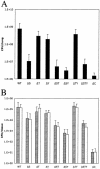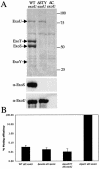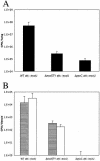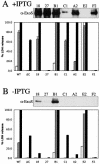Activities of Pseudomonas aeruginosa effectors secreted by the Type III secretion system in vitro and during infection
- PMID: 15731070
- PMCID: PMC1064929
- DOI: 10.1128/IAI.73.3.1695-1705.2005
Activities of Pseudomonas aeruginosa effectors secreted by the Type III secretion system in vitro and during infection
Abstract
Pseudomonas aeruginosa utilizes a number of distinct pathways to secrete proteins that play various roles during infection. These include the type II secretion system, which is responsible for the secretion of the majority of exoproducts into the surrounding environment, including toxins and degradative enzymes. In contrast, the type III secretion system mediates the delivery of protein effectors directly into the cytoplasm of the host cell. Using tissue culture assays and a mouse acute-pneumonia model, we have determined the contribution of each of the type III effectors during infection. In strain PAK, ExoS is the major cytotoxin required for colonization and dissemination during infection. ExoT confers protection of tissue culture cells from type III-dependent lysis, while ExoY seemed to have little effect on cytotoxicity. ExoU is over 100-fold more cytotoxic than ExoS. The cytotoxicity of type II secretion was determined following deletion of the genes for the more toxic type III secretion system. The participation of these secretion systems during lifelong colonization of cystic fibrosis (CF) patients is unclear. By comparing clonal strains from the same patient isolated at the initial onset of P. aeruginosa infection and more than a decade later, after chronic colonization has been established, we show that initial strains are more cytotoxic than chronic strains that have evolved to reduce type III secretion. Constitutive expression of genes for the type III secretion system restored ExoS secretion but did not always reestablish cytotoxicity, suggesting that CF strains accumulate a number of mutations to reduce bacterial toxicity to the host.
Figures








Similar articles
-
Relative contributions of Pseudomonas aeruginosa ExoU, ExoS, and ExoT to virulence in the lung.Infect Immun. 2004 Dec;72(12):6969-77. doi: 10.1128/IAI.72.12.6969-6977.2004. Infect Immun. 2004. PMID: 15557619 Free PMC article.
-
Role of the type III secreted exoenzymes S, T, and Y in systemic spread of Pseudomonas aeruginosa PAO1 in vivo.Infect Immun. 2005 Mar;73(3):1706-13. doi: 10.1128/IAI.73.3.1706-1713.2005. Infect Immun. 2005. PMID: 15731071 Free PMC article.
-
The exoS, exoT, exoU and exoY Virulotypes of the Type 3 Secretion System in Multidrug Resistant Pseudomonas aeruginosa as a Death Risk Factor in Pediatric Patients.Pathogens. 2024 Nov 22;13(12):1030. doi: 10.3390/pathogens13121030. Pathogens. 2024. PMID: 39770290 Free PMC article.
-
Role of Pseudomonas aeruginosa type III effectors in disease.Curr Opin Microbiol. 2009 Feb;12(1):61-6. doi: 10.1016/j.mib.2008.12.007. Epub 2009 Jan 23. Curr Opin Microbiol. 2009. PMID: 19168385 Review.
-
Immuno-modulatory functions of the type-3 secretion system and impacts on the pulmonary host defense: A role for ExoS of Pseudomonas aeruginosa in cystic fibrosis.Toxicon. 2018 Mar 1;143:68-73. doi: 10.1016/j.toxicon.2018.01.004. Epub 2018 Jan 12. Toxicon. 2018. PMID: 29339019 Review.
Cited by
-
Contact lens-related corneal infection: Intrinsic resistance and its compromise.Prog Retin Eye Res. 2020 May;76:100804. doi: 10.1016/j.preteyeres.2019.100804. Epub 2019 Nov 20. Prog Retin Eye Res. 2020. PMID: 31756497 Free PMC article. Review.
-
Virulence and Metabolism Crosstalk: Impaired Activity of the Type Three Secretion System (T3SS) in a Pseudomonas aeruginosa Crc-Defective Mutant.Int J Mol Sci. 2023 Aug 1;24(15):12304. doi: 10.3390/ijms241512304. Int J Mol Sci. 2023. PMID: 37569678 Free PMC article.
-
Population structure of Pseudomonas aeruginosa from five Mediterranean countries: evidence for frequent recombination and epidemic occurrence of CC235.PLoS One. 2011;6(10):e25617. doi: 10.1371/journal.pone.0025617. Epub 2011 Oct 3. PLoS One. 2011. PMID: 21984923 Free PMC article.
-
The impact of simvastatin on pulmonary effectors of Pseudomonas aeruginosa infection.PLoS One. 2014 Jul 10;9(7):e102200. doi: 10.1371/journal.pone.0102200. eCollection 2014. PLoS One. 2014. PMID: 25010049 Free PMC article.
-
Presence of exoY, exoS, exoU and exoT genes, antibiotic resistance and biofilm production among Pseudomonas aeruginosa isolates in Northwest Iran.GMS Hyg Infect Control. 2016 Feb 22;11:Doc04. doi: 10.3205/dgkh000264. eCollection 2016. GMS Hyg Infect Control. 2016. PMID: 26958458 Free PMC article.
References
-
- Bally, M., A. Filloux, M. Akrim, G. Ball, A. Lazdunski, and J. Tommassen. 1992. Protein secretion in Pseudomonas aeruginosa: characterization of seven xcp genes and processing of secretory apparatus components by prepilin peptidase. Mol. Microbiol. 6:1121-1131. - PubMed
-
- Banwart, B., M. L. Splaingard, P. M. Farrell, M. J. Rock, P. L. Havens, J. Moss, M. E. Ehrmantraut, D. W. Frank, and J. T. Barbieri. 2002. Children with cystic fibrosis produce an immune response against exoenzyme S, a type III cytotoxin of Pseudomonas aeruginosa. J. Infect. Dis. 185:269-270. - PubMed
-
- Dacheux, D., J. Goure, J. Chabert, Y. Usson, and I. Attree. 2001. Pore-forming activity of type III system-secreted proteins leads to oncosis of Pseudomonas aeruginosa-infected macrophages. Mol. Microbiol. 40:76-85. - PubMed
-
- Feltman, H., G. Schulert, S. Khan, M. Jain, L. Peterson, and A. R. Hauser. 2001. Prevalence of type III secretion genes in clinical and environmental isolates of Pseudomonas aeruginosa. Microbiology 147:2659-2669. - PubMed
Publication types
MeSH terms
Substances
Grants and funding
LinkOut - more resources
Full Text Sources
Other Literature Sources
Medical

